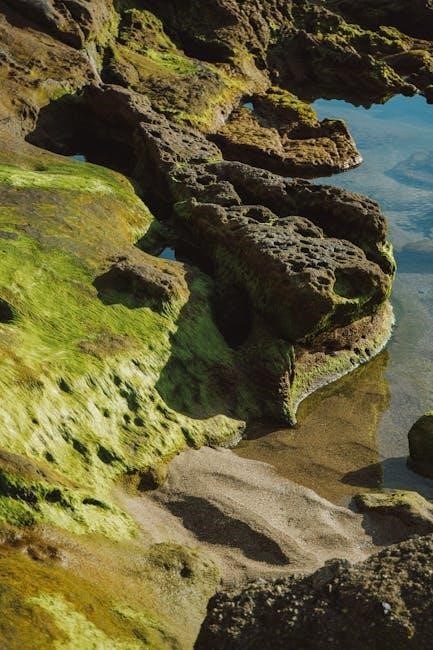Techniseal EZ Sand is a state-of-the-art joint stabilizer designed for pavers, combining graded sand and binder for easy installation․ It prevents weed growth and erosion, ensuring long-lasting stability․
Overview of Techniseal EZ Sand
Techniseal EZ Sand is a state-of-the-art joint stabilizing material designed for paver, stone, and block installations․ It is a unique blend of graded sand and binder, creating a durable and weed-resistant joint․ This product is specifically formulated to lock pavers in place, preventing erosion and shifting caused by weather or foot traffic․ EZ Sand is easy to apply and sweep into joints, making it a popular choice for residential and commercial projects․ Its polymeric properties enhance joint stability while reducing weed growth, ensuring a clean and professional appearance․ Unlike traditional sand, Techniseal EZ Sand forms a strong bond between pavers, providing long-lasting results․ It is ideal for outdoor spaces like patios, walkways, and driveways, offering both functionality and aesthetic appeal․ By using EZ Sand, homeowners and contractors can achieve a stable and visually appealing paver installation with minimal maintenance․
Importance of Following Instructions

Following the instructions for Techniseal EZ Sand is crucial to ensure a successful and long-lasting paver installation․ Proper application prevents issues like erosion, uneven joints, and weed growth, which can lead to costly repairs․ The product is designed to be applied under specific conditions, such as over a dense graded sand base and a proper drainage system․ Deviating from these guidelines can compromise the stability and appearance of the pavers․ Detailed steps, including site preparation, sand bedding, and joint stabilization, must be executed precisely to achieve optimal results․ Neglecting these instructions may result in premature wear or failure of the jointing material․ By adhering to the recommended process, homeowners and contractors can ensure a durable, weed-resistant, and visually appealing outdoor space․ Proper installation not only enhances the functionality of the area but also maintains the aesthetic value of the pavers for years to come․

Materials and Tools Needed
Essential materials include Techniseal EZ Sand, pavers, and a dense graded sand base․ Tools required are a wheelbarrow, broom, compactor, and trowel for proper installation and finishing․

Required Materials for Installation
To successfully install pavers using Techniseal EZ Sand, you will need several key materials․ First, ensure you have a sufficient supply of Techniseal EZ Sand itself, which is specifically designed for joint stabilization․ Additionally, you will need pavers of your choice, whether they are concrete, stone, or brick․ A dense graded sand base is also essential for proper drainage and stability․ Other materials include edge restraints to secure the pavers in place and a compactible base material, such as gravel, to create a solid foundation․ Lastly, water is required to activate the binder in the EZ Sand․ Having all these materials ready ensures a smooth and efficient installation process․ Make sure to follow the manufacturer’s recommendations for quantities to avoid shortages or excess․ Proper material preparation is critical for achieving professional-grade results․
Essential Tools for the Process
To ensure a successful installation using Techniseal EZ Sand, you will need several essential tools․ A wheelbarrow or mixing container is necessary for blending the sand and binder․ A broom or squeegee is required to spread the sand evenly between paver joints․ A plate compactor is crucial for compacting the sand and ensuring stability․ Additionally, a level tool will help maintain evenness across the surface․ A trowel or small brush can be used for fine adjustments in tight spaces․ Water is also needed, so a garden hose with a spray nozzle is essential․ Lastly, safety gear, such as gloves and goggles, should be worn to protect yourself during the process․ Having these tools on hand will streamline the installation and ensure professional-grade results․ Proper use of these tools is vital for achieving a durable and aesthetically pleasing finish․
Surface Preparation
Proper surface preparation is critical for a successful installation․ Evaluate the site, clear debris, and level the ground․ Lay a stable base course and prepare the sand bedding for optimal results․
Site Evaluation and Planning
Before starting the installation, evaluate the site to ensure it is suitable for paver placement; Check for proper drainage and levelness, as uneven ground can lead to instability․ Plan the layout carefully, considering the intended use and desired aesthetic․ Ensure the area is clear of debris and obstructions․ Proper site evaluation helps prevent future issues like erosion or uneven settling․ A well-planned base course and drainage system are essential for long-term stability․ Take time to mark the area accurately, ensuring alignment with surrounding structures․ Adequate planning ensures a smooth installation process and a professional finish․ Always follow the manufacturer’s guidelines for site preparation to achieve optimal results with Techniseal EZ Sand․
Clearing and Leveling the Area
Clearing and leveling the area is a critical step before installing pavers with Techniseal EZ Sand․ Start by removing all debris, vegetation, and obstructions from the site․ Mark the boundaries of the area where the pavers will be laid․ Use a shovel or sod cutter to remove grass and topsoil, ensuring the surface is even and level․ Check the slope to ensure proper drainage, as standing water can damage the installation․ Use a rake or leveling tool to smooth the ground, achieving a uniform base․ Compact the soil using a hand tamper or plate compactor to prevent settling․ A well-prepared and leveled surface ensures the pavers will lie flat and stable, providing a professional finish․ Proper clearing and leveling are essential for the long-term durability and appearance of the paver installation․

Laying the Base Course
Laying the base course is a fundamental step in preparing the site for pavers․ Begin by spreading a layer of compacted gravel or aggregate material, ensuring it covers the entire area evenly․ The base course should be approximately 4-6 inches thick, depending on the intended use of the paver installation․ Use a shovel or spreader to distribute the material, then compact it thoroughly with a plate compactor or hand tamper․ This step ensures the base is stable and prevents settling or shifting over time․ Once compacted, rake the surface to create a smooth, even layer․ Properly laying the base course is essential for achieving a durable and long-lasting paver installation․ It provides the structural foundation needed to support the weight of the pavers and ensures proper drainage․ A well-prepared base course is critical for the success of the entire project․
Preparing the Sand Bedding
Preparing the sand bedding is a critical step before laying pavers․ Spread a layer of dense-graded sand evenly across the base course, ensuring it covers the entire area․ The recommended thickness for the sand bedding is typically 1-1․5 inches․ Use a shovel or spreader to distribute the sand, then rake it to achieve a smooth, even surface․ Compact the sand lightly with a hand tamper or plate compactor to create a stable base․ Proper compaction ensures the sand adheres well to the base course and provides a solid foundation for the pavers․ After compacting, check the surface for any uneven areas and make adjustments as needed․ A well-prepared sand bedding layer is essential for achieving proper drainage and preventing shifting or settling of the pavers over time․ This step sets the stage for a successful and durable paver installation․

Installation Process
Techniseal EZ Sand streamlines paver installation by stabilizing joints․ Lay pavers on a prepared sand base, spread EZ Sand, and sweep it into gaps․ Compact thoroughly for lasting stability․
Laying Pavers on the Sand Base
Laying pavers on the sand base requires precision to ensure a stable and even surface․ Begin by placing the first paver at the starting point, aligning it with your design plan․ Use a rubber mallet to gently tap each paver into place, ensuring it sits firmly on the sand base․ Maintain consistent spacing between pavers, typically 1/8 inch, to allow for proper sand filling․ As you progress, use a level to check the alignment and slope, making adjustments as needed․ For curved designs, cut pavers to fit using a saw or breaker․ Once all pavers are laid, double-check the entire area for evenness and proper fit before moving on to the next step․ This step is crucial for the overall durability and appearance of your installation․
Spreading Techniseal EZ Sand
Spreading Techniseal EZ Sand is a critical step in ensuring proper joint stabilization․ Begin by sweeping the sand evenly across the paver joints using a broom, working in small sections to maintain control․ Make sure to fill the joints completely, but avoid overfilling, as excess sand can hinder the binding process․ Use a brush or broom to remove any sand from the paver surfaces, ensuring it settles only in the gaps․ Once spread, use a vibrating plate compactor or hand tamper to compact the sand, allowing it to settle deeply into the joints․ This step ensures the sand binds effectively, locking the pavers in place and preventing future shifting or erosion․ Proper spreading and compaction are essential for achieving a durable and weed-resistant surface․ Follow the manufacturer’s instructions for optimal results․ This process ensures long-lasting stability and a professional finish for your paver installation․
Sweeping and Compacting the Sand
Sweeping and compacting the sand is a vital step in the installation process․ After spreading the Techniseal EZ Sand, use a broom or brush to sweep it evenly into the joints, ensuring all gaps are filled․ Avoid leaving excess sand on the paver surfaces, as this can interfere with the binding process․ Once the sand is evenly distributed, use a vibrating plate compactor or a hand tamper to compact the sand․ This step ensures the sand settles deeply into the joints, creating a stable and durable bond between the pavers․ Compacting also helps prevent shifting and erosion over time․ It’s important to work in small sections and repeat the compaction process as needed until the sand is firmly in place․ Proper sweeping and compaction are essential for achieving a professional-looking finish and ensuring the longevity of your paver installation․
Finalizing the Joint Stabilization
After sweeping and compacting the sand, the final step is to ensure the joints are fully stabilized․ Inspect the pavers to confirm all gaps are filled evenly and there are no excess sand residues on the surface․ For optimal results, lightly mist the area with water to activate the binder in the Techniseal EZ Sand․ This step helps lock the sand in place, enhancing joint stability and preventing erosion․ Allow the surface to dry completely before exposing it to foot traffic or water․ Regular inspection and maintenance will ensure the joints remain stable over time․ Proper finalization of the joint stabilization ensures a durable and professional-looking paver installation, resistant to weeds and shifting․ This step is crucial for achieving the desired longevity and aesthetic appeal of your paver project․
Key Features and Benefits
Techniseal EZ Sand is a state-of-the-art mix of graded sand and binder, designed to reduce weed growth and prevent erosion․ It enhances joint stability and is ideal for residential paver installations․
Advantages of Using EZ Sand
Techniseal EZ Sand offers numerous benefits, making it a top choice for paver installations․ Its unique blend of graded sand and binder ensures superior joint stabilization, reducing weed growth and erosion․ It is easy to apply, saving time and effort during installation․ The material locks pavers in place, providing long-lasting stability and durability․ Additionally, EZ Sand enhances the overall appearance of paver surfaces by creating clean, uniform joints․ Its ability to prevent shifting and settling ensures a professional finish․ With EZ Sand, homeowners and contractors can achieve a low-maintenance, weed-resistant paver system that withstands heavy foot traffic and harsh weather conditions; These advantages make Techniseal EZ Sand an ideal solution for residential and commercial paver projects․
How EZ Sand Reduces Weed Growth
Techniseal EZ Sand effectively reduces weed growth by creating a tight seal between pavers․ Its unique blend of graded sand and binder fills joints completely, preventing seeds from germinating and weeds from growing․ The material locks pavers in place, eliminating gaps where weeds typically emerge․ By stabilizing the joints, EZ Sand minimizes soil movement, which is a common cause of weed growth․ Additionally, its water-resistant properties reduce moisture retention, further discouraging weed development․ This makes EZ Sand an excellent choice for maintaining a clean, weed-free paver surface․ Regular use of EZ Sand ensures long-term joint stability and reduces the need for frequent weeding․ Its effectiveness in preventing weed growth makes it a popular option for both residential and commercial paver installations․
Enhanced Joint Stability
Techniseal EZ Sand significantly enhances joint stability by locking pavers firmly in place․ Its unique blend of graded sand and binder fills gaps completely, preventing paver movement and shifting․ Once applied, the sand hardens to create a strong, durable bond between pavers, ensuring a stable surface․ This stability is crucial for withstanding foot traffic, weather conditions, and other environmental factors․ The material’s water-resistant properties further enhance its performance, reducing erosion and maintaining joint integrity․ By stabilizing the joints, EZ Sand prevents the pavers from settling unevenly, which can lead to structural issues over time․ This enhanced stability not only improves the appearance of the paver surface but also extends its lifespan․ Regular use of EZ Sand ensures that the joints remain secure, providing a solid foundation for years to come․
Maintenance and Upkeep
Regular cleaning and inspections are essential to maintain the integrity of Techniseal EZ Sand․ Replenish sand as needed and protect the surface from damage to ensure long-lasting stability and appearance․
Regular Cleaning and Inspection

Regular cleaning and inspection are crucial for maintaining the durability and appearance of surfaces installed with Techniseal EZ Sand․ Start by sweeping the area thoroughly to remove dirt, debris, or leaves that may accumulate․ This helps prevent the growth of weeds, which can undermine the stability of the joints․ Inspect the sand-filled joints for signs of erosion or uneven settling, as these issues can lead to structural problems over time․ If you notice any gaps or low areas, address them promptly by replenishing the sand․ Additionally, check for weeds and remove them manually or with appropriate herbicides to prevent root damage․ Regular maintenance ensures the sand remains tightly packed, providing a stable and attractive surface․ By staying proactive, you can extend the lifespan of your paver installation and keep it looking its best․
Replenishing Sand as Needed
Replenishing sand is essential to maintain the integrity and appearance of your paver installation․ Over time, weather conditions like rain or heavy foot traffic can cause the sand to erode or settle unevenly․ Inspect the joints regularly, especially after seasonal changes, to identify areas where the sand may be depleted․ When replenishment is needed, use the same type of sand, such as Techniseal EZ Sand, to ensure consistency and proper bonding․ Spread the sand evenly across the affected joints, using a broom to sweep it into the gaps․ Compact the area lightly to settle the sand and provide stability․ Avoid overfilling, as excess sand can lead to a messy appearance․ Replenishing sand promptly prevents weeds from taking root and maintains the structural stability of your pavers․ This simple maintenance step ensures your installation remains durable and visually appealing for years to come․
Protecting the Surface from Damage
Protecting your paver surface from damage is crucial for maintaining its appearance and longevity․ Regular cleaning is essential to remove dirt, debris, and stains that can degrade the material․ Use a mild detergent and water for cleaning, avoiding harsh chemicals that might harm the pavers or the sand․ Sealing the surface with a high-quality sealant can provide additional protection against stains and weathering․ Avoid placing heavy objects directly on the pavers, as they can cause cracks or shifting․ If you must place heavy furniture or equipment, use protective pads to distribute the weight evenly․ Direct water flow away from the paver surface to prevent erosion and damage․ Trim nearby plants regularly to avoid root growth that could disrupt the pavers․ Address any cracks or uneven areas promptly to prevent further damage․ By following these steps, you can ensure your paver installation remains durable and visually appealing for years to come․

Troubleshooting Common Issues
Common issues with Techniseal EZ Sand include erosion, uneven joints, and weed growth․ Address these by ensuring proper installation, regular maintenance, and following the manufacturer’s instructions closely․

Addressing Erosion Problems
Erosion can occur if Techniseal EZ Sand is not properly compacted or if heavy rainfall washes away the material․ To address this, inspect the affected areas and replenish the sand as needed․ Use a broom to sweep the sand into the joints, ensuring even distribution․ Compact the sand using a hand tamper or plate compactor to create a stable surface․ For severe erosion, reapply a thin layer of EZ Sand and follow the manufacturer’s instructions for proper setting․ Regular maintenance, such as periodic inspections and touch-ups, can help prevent future erosion issues․ Additionally, ensuring proper drainage during installation can minimize the risk of erosion․ By addressing erosion promptly, you can maintain the integrity and appearance of your paver installation․
Dealing with Weed Growth
Weed growth can occur in paver joints if Techniseal EZ Sand is not properly applied or maintained․ To address this, start by removing weeds manually or with a herbicide․ Reapply a thin layer of EZ Sand, sweeping it thoroughly into the joints․ Compact the sand to ensure it fills gaps completely, preventing seeds from germinating․ Regular maintenance, such as periodic sweeping and inspection, can help reduce weed growth․ Additionally, ensuring proper drainage and keeping the surface clean can inhibit weed development․ For persistent issues, consider sealing the pavers to further block weed growth․ By following these steps, you can maintain a clean and stable paver installation, enhancing its durability and aesthetic appeal․

Fixing Uneven Joints
Uneven joints can occur due to improper sand compaction or settling over time․ To fix this, start by assessing the uneven areas and removing any loose or excess sand․ Reapply Techniseal EZ Sand evenly, sweeping it into the joints with a broom to fill gaps․ Use a compactor or hand tamper to firmly press the sand into place, ensuring a level surface; Repeat the process if necessary to achieve even joint stabilization․ Proper compaction is key to preventing future unevenness․ Regular inspections and maintenance can help identify and address issues early․ By following these steps, you can restore the integrity and appearance of your paver installation, ensuring long-lasting stability and a professional finish․
Techniseal EZ Sand is a state-of-the-art solution for paver installations, offering durability and aesthetic appeal․ By following the instructions, you ensure a professional finish and long-lasting results․
Using Techniseal EZ Sand involves several key steps to ensure a professional and durable paver installation․ Start by preparing the site, including leveling the ground and laying a stable base course․ Next, spread the EZ Sand evenly across the paver joints, ensuring full coverage․ Use a broom to sweep the sand deeply into the gaps, then compact the surface to lock the pavers in place․ Finally, inspect the area and replenish sand as needed to maintain joint stability․ Properly following these steps ensures a clean, weed-resistant, and erosion-free finish․ The process is designed to be straightforward, but attention to detail is crucial for long-lasting results․ By adhering to the instructions, you can achieve a beautiful and functional outdoor space that withstands the elements and remains visually appealing for years․
Final Tips for Success
For a successful installation using Techniseal EZ Sand, ensure proper site preparation and follow instructions meticulously․ Always use the recommended materials and tools to avoid complications․ Compact the base and sand bedding thoroughly before laying pavers․ When spreading EZ Sand, work in small sections to maintain even coverage․ Use a broom to sweep sand deeply into joints, and compact the surface multiple times to lock pavers in place․ Regularly inspect the area for erosion or uneven joints and address them promptly․ Maintain the surface by cleaning debris and replenishing sand as needed․ Protect the pavers from heavy loads or sharp objects to prevent damage․ By adhering to these tips, you’ll achieve a durable, weed-resistant, and visually appealing outdoor space that lasts for years․ Proper care and attention ensure the longevity of your paver installation․
